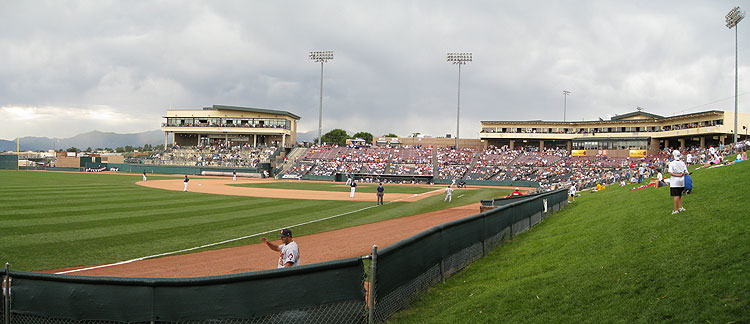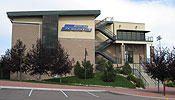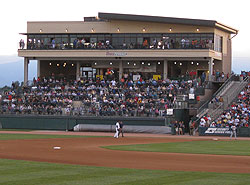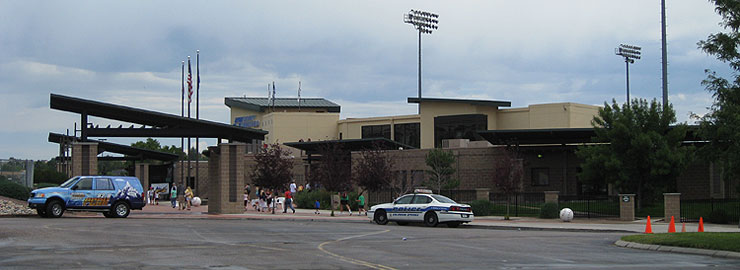
|
In 1984 a new ballpark opened in the southern limits of Greenville, SC for the Atlanta Braves’ Double-A team. Simply called Municipal Stadium, it had a single entrance behind home plate, a drab interior with a symmetrical seating bowl that barely extended beyond the infield, and speakers placed on the concourse, from which sound echoed so that it was barely intelligible. No quirks, no charm and poorly located (and lighted), it was a bad ballpark.
Fortunately for residents of Colorado’s second largest city, what opened in 1988 as a Municipal Stadium clone has morphed into something much better than that now abandoned ballpark (the G-Braves left in 2004). Even so, Security Service Field looks like a facility that was built in 1988 and has expanded over the years to remain serviceable. Security Service Field is a rather unassuming ballpark by Triple-A standards, thanks in part to it being the smallest of the 30 used at the minors’ highest level. With a listed capacity of 8,400, the Sky Sox’s stadium is one of just five to seat less than 10,000 in Triple-A, with the next quaintest being the 8,943-seater in Toledo. Although it’s dead last in capacity, Security Service Field is number one in elevation. At 6,531 feet above sea level, it's the highest professional ballpark in the United States. Unfortunately for fans, not only was the ballpark built in eastern Colorado Springs, it was built to face east, a necessary orientation made in most ballparks to ensure that the sun remains out of the batters’ eyes. But that concession to players is bad for the fans who want a scenic mountain backdrop. The state of Colorado may be noted for them, but Security Service Field isn’t as Cheyenne Mountain and Pikes Peak, both a part of the Rocky Mountain range, are to the west. The only mountains that fans in the grandstand can view are the replica peaks of the Rockies that adorn the scoreboard in left-center field. Placed atop the 42’ high by 55’ wide structure, the decorative feature is also functional as the mountain scene lights up following each Sky Sox home run and victory. The ballpark’s scoreboard has always been in the same place, but was completely refurbished in 2007 to include a 15’ x 22’ video screen. The modernization within the ballpark was in no way limited to the scoreboard that stands just outside of it, as renovations and enhancements have contributed heavily to the present-day experience of seeing a game at Security Service Field.
Fans preferring to sit outside yet still be secluded will enjoy the Coors Picnic Terrace, which extends from the four story building to the playing field. The terrace has five levels, each of them accommodating approximately 100 people on outdoor patio-style tables and chairs. The third floor of the building serves as a concourse for fans in the picnic terrace, who along with banquet hall ticket holders are the only ones that can access it. While the four story building, which has no official name so it must be referred to as such, is fairly novel, the addition of a hot tub upon a wooden deck down the right field line has become a common ballpark amenity over the years. Colorado Springs’ holds eight and includes a bottle of champagne for those who rent it. But the Sky Sox make it a point that “all other alcoholic beverages are not permitted in the spa area.” Alcohol flows freely throughout the rest of the ballpark. Coors and Coors Light are a natural fit and local microbrews are among a wide variety found on tap. Concession fare is about what you’d normally expect, with one notable and decadent exception, as a Rocky Mountain Chocolate Factory is nestled just inside of the ballpark’s single entrance behind home plate. ‘ Upon entering, fans can grab a free copy of The Inside Pitch, a neat little full color program that lists the “eats & treats” found at the handful of concession stands within the ballpark. Baseball fans should visit the Hall of Fame Bar & Grill along the third base concourse. The menu isn’t much – bar food are staples – but the décor that adorns the walls is dedicated to great moments and players in Sky Sox history. The featured display gives the bar and grill its name, as framed jerseys with descriptive plaques beneath tell the story of each man that’s been enshrined into the team’s Hall of Fame. The first inductee into the Sky Sox Hall of Fame was Luis Medina, who hit 76 home runs during parts of four seasons with the team, and he and all other honored individuals are celebrated with circular markers on the façade of the luxury suites erected behind home plate. The 18 skyboxes that make up the suite level are also responsible for the only shade in the ballpark, as they cover all fans standing in the concourse below. Otherwise, the only roofs on site are the green awnings outside of the ballpark, one of which shades those buying tickets at the box office. Fans purchasing tickets in the grandstand have the option of box or reserved seats. The two sections are split by a mid-level aisle. The 2,536 box seats below it are painted green and have cup holders attached. The reserved seats above the aisle are aluminum bleachers with red-hued backs. The main concourse is above the grandstand and open to the playing field, a fan-friendly design ahead of its time for a ballpark that harkens to the 1980s. In a departure from the modern norm, members of the media work from a press box on the concourse level rather than having a perch above it. The concourse wraps as much as the stadium as it’s allowed. The four story building is the ending point in right, but the concourse extends most of the length of the left field line, where it’s home to the Fun Zone, a pay-for-play spot for kids that has inflatables and a speed pitch cage. Below the Fun Zone is a sizeable grassy hill. It’s only from the berm that fans can enjoy glimpses of the mountains to the ballpark’s west. One mistake that this ballpark copied from Greenville but failed to correct was their idea of a sound system. In each, speakers were not attached high up light towers as is custom. Instead, they’re haphazardly strung together on poles behind the last row of seats in the grandstand. This concourse level placement of the speakers ensures their audio is muffled and most PA announcements are difficult to understand as a result.
Intimacy such as that is the one aspect this ballpark truly gets right. The grandstand is close to the playing field and, because it only extends two sections beyond each dugout, all fans are close to the action, especially those in the box seats. Fans in the berm can stand directly behind where the visiting team’s pitchers sit in their bullpen, which is cut into the bottom of the grassy hill. The Sky Sox bullpen isn’t as accessible, as it’s wedged between the hot tub deck and where the tarp is stored in foul territory down the right field line. All fans are pretty much guaranteed a close encounter with the Sky Sox’s mascot if they desire. Sox the Fox is easy to spot wherever he is in the ballpark, partially because it’s so small and he has less room to roam as the confines of Security Service Field end at the foul poles. Not far beyond the ad covered outfield walls lies the plains upon which urban sprawl has encroached. The fairway of the 12th hole of the Springs Ranch golf course is visible behind left field and further in the distance endless rows of tract housing dominate the landscape. The right field wall contains two digital displays, one for the time and the other listing the MPH of each pitch. Beyond that wall is a crater-like basin where run-off from a creek collects. While certainly not an eyesore, the exterior of Security Service Field is underwhelming. It’s constructed of sandstone colored brick, each the size of a cinder block. A cul-de-sac near the main entrance allows fans to be dropped off in an area covered by a slanted green awning. The portion of the exterior that towers above the rest is the four story building, which is the dominant focal point for all who park in the general parking lot. Because it was built on a slightly downward sloping hill, the backside of all four stories are exposed. The building’s attractive facade and manicured landscaping give it the air of a main entrance, but only banquet hall or terrace ticket holders will be admitted after climbing the two flights of stairs that must be ascended to arrive at the building’s glass doors. Getting fans to come to the ballpark has been a problem for the front office in Colorado Springs. In 2008 the Sky Sox finally topped 300,000 in home attendance for the first time, but the 303,048 fans that came through the Security Service Field turnstiles ranked the team just 28th out of 30 in Triple-A. Only the Richmond Braves and Tucson Sidewinders drew less, and both teams moved following the season. To encourage locals to support their home team management has made wallet-friendly offers an annual addendum to the Colorado Springs promotional schedule. Such staples include $2 Tuesdays (tickets, parking and beer are just two bucks) and 50¢ hot dogs on Sundays. The Sky Sox also tout bonus books, which are undated vouchers sold at deep discounts. While many teams use their ballpark as their main draw the Sky Sox promote affordability to bring fans to theirs. Security Service Field is nowhere near the wonderland that ballparks built since 1988 have become, but the millions of dollars the team has poured into upgrades in the 21st century have clearly set it apart from what it once was. Although it still bears some resemblance to what I disliked so much at the old yard in Greenville, the modified Colorado Springs version doesn’t leave the same negative impression. But the problem with Security Service Field is that you don’t get the type of ballpark you’d expect at the Triple-A level, nor do you get views of the area’s signature and nearby mountain ranges. That makes a visit to this ballpark disappointing. Security Service Field may be the highest ballpark in the country, but the home of the appropriately named Sky Sox will never rank very high compared to its lower elevation brethren. What Colorado Springs has is a functional ballpark, but not much more. And in this day and age we all expect more.
Location and ParkingThe live, work, play concept predates the ballpark by a about a decade, but Security Service Field feels like an unplanned version of it. When it opened in 1988, the Sky Sox's stadium was an oasis in an area of emptiness. That's no longer the case. Growth around the ballpark has exploded to the point where it almost gets lost in all the surrounding development, which includes just about every chain a diner or shopping could desire. Red Robin, Target, you name it and you'll drive by it en route to the ballpark, which is about a mile east of I-25. In addition to all the places to spend money, neighborhoods full of tract housing popped up on the once barren plains beyond the outfield. Those residents can enjoy the entertainment the Sky Sox provide or choose to tee off on the public golf course that passes between the ballpark and their residences. Completing the recreation trifecta is Sandcreek Stadium, a small soccer venue elevated about 10 feet above and behind the baseball stadium's main entrance. Parking lots flank both sides of Security Service Field, but the eastern lot (third base side) is reserved for pass-bearing season ticket holders. A large paved lot on the west (first base) side is where the masses park. There's only one road in and out of that lot, so traffic congestion can be a problem if large crowds are present.
HistoryThe Sky Sox franchise is an original member of the Pacific Coast League, which began operation in 1903. The team which came into being as the Sacramento Solons in 1903 moved to Honolulu and became the Islanders in 1961 before finally returning to the mainland and Colorado Springs in 1988. Upon their return to the continental US the franchise took the name of the last pro team to play in the city. The original Sky Sox were a Single-A team in the Western League from 1950–1958. They played in downtown Colorado Springs at Spurgeon Field, which is where the reborn Sky Sox would find themselves for 19 games in 1988 when financing difficulties first threatened then delayed construction on Sky Sox Stadium. When David Elmore, who owns the team to this day, moved the franchise from Hawaii to Colorado it was agreed he would be responsible for building a new ballpark. In need of land, Elmore struck a deal with a private developer, AmWest, whereby he was deeded 15 acres of a 90-acre parcel that was zoned for park use. AmWest received a $234,000 tax credit from the city for their good deed. The city of Colorado Springs also agreed to compensate Elmore a half million dollars in return for him agreeing to a joint-use agreement that allowed the city to use the stadium for 180 days per year through 2002. Most of the $500,000 that the city paid Elmore came from a tourism fund that dated to 1976. For his part, Elmore needed to secure a $1.5 million loan to start construction on the stadium, which was scheduled to begin January 4, 1988 and set to be completed on April 21. But it wasn't until March 15 that a local resident named Gary Loo agreed to finance the stadium in return for a 20% equity stake in the stadium corporation. Two months behind schedule, there was no way the new stadium would be ready in time for the start of the 1988 PCL season. The league thereby scheduled the Sky Sox to play their first eight home games 1,081 miles from Colorado Springs in Yuma, Arizona's Desert Sun Stadium, the then spring training home of the Padres. Home ballpark #2 for the 1988 Sky Sox was where the Sky Sox of 1958 had played, Spurgeon Field, which was in a larger city park called Memorial Park. The location was so residential that beer sales weren't allowed at the ballpark. Even worse, the lighting at the 5,000-seat field was so antiquated that all games had to be played during the afternoon. Finally, on June 18 the beer would be able to flow and the Sky Sox could play under the lights at their new home, which cost $3.4 million to build and just 80 days to construct. Simply called Sky Sox Stadium, an overflow crowd of 8,763 showed up on its opening night but the Sky Sox never really did, losing to the Tucson Toros 14-6. Initially a Cleveland Indians affiliate, the Sky Sox became a part of the Colorado Rockies' family in 1993 when Major League Baseball expanded to Denver. In February 2005 expansion and renovation plans for Sky Sox Stadium were announced, along with a new name. Thanks to a "partnership agreement" with Security Service Federal Credit Union all enhancements would be privately financed and the stadium rebranded Security Service Field. The chief additions to the ballpark were a four story banquet hall and five-tier picnic terrace. Locally based Barnes Architects and Bryan Construction were hired to design and build the add-ons. Among the other areas receiving upgrades were the main gate area, the luxury suite level, and player and umpire facilities. In March 2007 the stadium's original scoreboard was replaced with a state-of-the-art one from Daktronics. The new scoreboard was the final major piece in a series of renovations that significantly spiffed up the place and when all was said and done the Sky Sox had spent about $8.5 million to make their old home new again.

Security Service Field Facts, Figures & Footnotes
| ||||||||||||||||||||||||||||||



 The most notable addition is the four story building down the right field line that opened in 2006. The first two floors of the building were dedicated to baseball operations needs, such as a new home clubhouse, indoor batting cages and weight training room. The upper two stories are group and hospitality areas, highlighted by the Centennial Banquet Hall, the year-round banquet facility on the fourth floor that can accommodate up to 250 people in climate controlled comforts. The banquet hall also has sliding glass doors that open up to an outdoor balcony seating area.
The most notable addition is the four story building down the right field line that opened in 2006. The first two floors of the building were dedicated to baseball operations needs, such as a new home clubhouse, indoor batting cages and weight training room. The upper two stories are group and hospitality areas, highlighted by the Centennial Banquet Hall, the year-round banquet facility on the fourth floor that can accommodate up to 250 people in climate controlled comforts. The banquet hall also has sliding glass doors that open up to an outdoor balcony seating area.
 Perhaps the most distinguishing feature at Security Service Field is the concrete steps at both ends of the grandstand. The ones on the first base side have no use, but the stairs between the third base grandstand and berm are the sole means for the visiting team’s players to get between the playing field and their clubhouse. Only a chain link fence separates fans from the players, so autograph and photo opportunities are guaranteed there.
Perhaps the most distinguishing feature at Security Service Field is the concrete steps at both ends of the grandstand. The ones on the first base side have no use, but the stairs between the third base grandstand and berm are the sole means for the visiting team’s players to get between the playing field and their clubhouse. Only a chain link fence separates fans from the players, so autograph and photo opportunities are guaranteed there.


